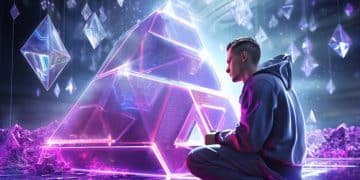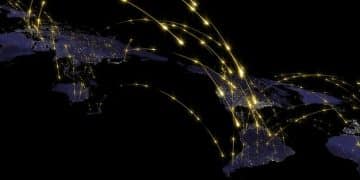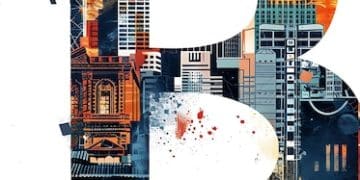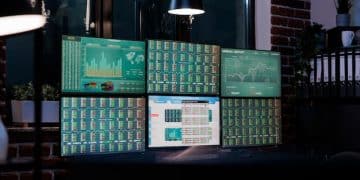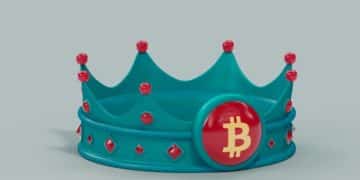Blockchain-Based Digital Art: NFTs and the Future of US Art Ownership
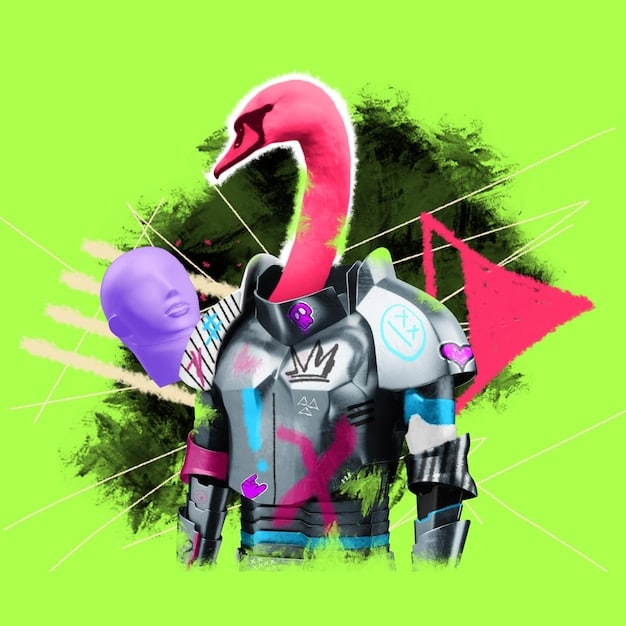
Blockchain-based digital art, particularly through Non-Fungible Tokens (NFTs), is revolutionizing art ownership in the US by providing unique, verifiable digital assets and enabling new forms of artistic creation and investment.
Dive into the innovative world of blockchain-based digital art, exploring how Non-Fungible Tokens (NFTs) are reshaping art ownership and creation in the US. Discover the technology, the market, and the future of art itself.
Understanding Blockchain-Based Digital Art and NFTs
Blockchain technology has opened up new avenues for digital art, primarily through NFTs. These unique tokens provide a method for verifying ownership and authenticity in the digital realm, addressing the longstanding challenges of digital art’s reproducibility.
The Basics of Blockchain and NFTs
Blockchain technology serves as a secure, transparent, and decentralized ledger. NFTs leverage this technology to represent ownership of unique digital items, making them verifiable and tradeable.
How NFTs Enable Digital Art
NFTs allow artists to tokenize their digital creations, providing proof of ownership and provenance. This has created a new market for digital art, enabling artists to sell their work directly to collectors.
- Enhancing Digital Art Scarcity: Creating verifiable limited editions.
- Empowering Artists: Providing new avenues for direct sales and royalties.
- Transforming Art Collecting: Enabling digital ownership and investment.
In essence, blockchain technology and NFTs have revolutionized how digital art is valued, owned, and traded, allowing artists to monetize their creations. This has led to a new wave of digital art innovation and investment.
The Rise of NFTs in the US Art Market
The US art market has seen a significant influx of NFTs, with digital art sales reaching unprecedented levels. This growth has been fueled by increased interest from both artists and collectors, leading to a transformation in how art is created, bought, and sold.

NFT Marketplaces and Platforms
Platforms like OpenSea, Rarible, and Nifty Gateway have become central hubs for the buying and selling of NFTs. These marketplaces offer a diverse range of digital artworks, from visual art to music and virtual real estate.
Notable NFT Art Sales in the US
Several high-profile NFT art sales have captured the attention of the US art world, including Beeple’s “Everydays: The First 5000 Days,” which sold for $69.3 million at Christie’s.
- Record-Breaking Sales: Highlighting the value placed on unique digital assets.
- Mainstream Adoption: Attracting interest from traditional art collectors.
- Digital Art as Investment: Establishing NFTs as a legitimate asset class.
These developments signal a shift in the art market, with NFTs gaining recognition as valuable and collectible assets. Artists and collectors are increasingly embracing NFTs, driving innovation and growth in the digital art space.
Legal and Regulatory Considerations for NFTs in the US
As NFTs gain popularity, legal and regulatory issues are becoming increasingly relevant. In the US, questions around copyright, intellectual property, and securities laws are being raised, necessitating a clear legal framework for digital art ownership.
Copyright and Intellectual Property
Copyright law in the US applies to digital art in the same way it does to traditional art. NFT creators retain copyright unless they explicitly transfer it to the buyer. However, the complexities of digital ownership and reproduction raise new challenges.
Securities Laws and NFTs
The US Securities and Exchange Commission (SEC) is scrutinizing whether certain NFTs qualify as securities. If an NFT is marketed as an investment with an expectation of profit, it may fall under securities regulations.
Navigating the legal and regulatory landscape is crucial for artists, collectors, and platforms.
- Compliance: Ensuring NFT sales and transactions comply with existing laws.
- Legal Clarity: Advocating for clear guidelines to protect artists and investors.
- Risk Mitigation: Understanding potential legal implications.
Addressing these issues is essential to foster a secure and sustainable environment for blockchain-based digital art in the US.
The Impact of NFTs on Artists and Creators
NFTs have profoundly impacted artists and creators by providing new avenues for monetization, direct engagement with fans, and control over their work.
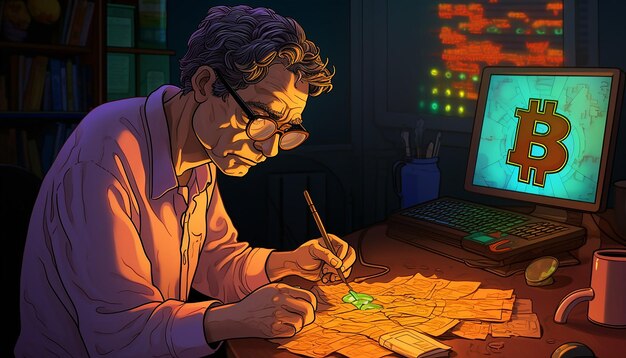
New Revenue Streams for Artists
NFTs enable artists to sell their work directly to collectors, bypassing traditional intermediaries like galleries and auction houses.
Direct Engagement with Collectors
NFTs facilitate closer relationships between artists and collectors, allowing for direct communication and community building.
NFTs are revolutionizing how artists create, sell, and connect with their audience.
- Empowering Independence: Granting artists more autonomy and control.
- Promoting Innovation: Encouraging new forms of digital art and expression.
- Building Community: Fostering meaningful connections.
By enabling artists to capture more value from their work and engage directly with fans.
Environmental Concerns and Sustainable NFTs
The environmental impact of blockchain technology, particularly the energy-intensive proof-of-work consensus mechanism, has raised concerns about the sustainability of NFTs. However, efforts are underway to address these issues and promote sustainable NFT practices.
Energy Consumption of Blockchain
Proof-of-work blockchains, like the original Ethereum, require significant energy to validate transactions, leading to a substantial carbon footprint.
Sustainable Alternatives
Newer blockchain technologies, such as proof-of-stake, offer a more energy-efficient alternative, reducing the environmental impact of NFTs.
Sustainability is a critical consideratio in the growing NFT market.
- Reducing Carbon Footprint: Opting for energy-efficient blockchains.
- Promoting Green NFTs: Encouraging artists and platforms to adopt sustainable practices.
- Offsetting Emissions: Investing in carbon offsetting initiatives.
By addressing environmental concerns, the NFT community can ensure the long-term sustainability of the digital art market.
The Future of Art Ownership and NFTs in the US
The future of art ownership in the US is increasingly intertwined with NFTs, with the potential for further innovation, adoption, and integration with traditional art markets. As technology evolves and regulations become clearer, NFTs are poised to play a central role in the art world.
Integration with Traditional Art Markets
Traditional art institutions are exploring partnerships and collaborations with NFT platforms.
New Forms of Digital Art
NFTs are fostering experimentation and innovation in digital art, leading to new forms of creative expression.
- Augmented Reality (AR) Art: Combining digital art with real-world environments.
- Interactive Art: Allowing collectors to engage with and customize their digital artworks.
The future of art ownership is dynamic, exciting, and full of possibilities.
Democratization of Art Ownership
NFTs are making art more accessible to a broader audience by enabling fractional ownership and lower investment thresholds.
| Key Concept | Brief Description |
|---|---|
| 🖼️ NFTs | Unique digital assets that represent ownership of art. |
| 🚀 Blockchain | Technology that secures and verifies digital ownership. |
| 💰 Art Market | NFTs are revolutionizing how art is bought and sold. |
| 🌱 Sustainability | Efforts to reduce the environmental impact of NFTs. |
Frequently Asked Questions (FAQ)
▼
An NFT (Non-Fungible Token) is a unique digital asset that represents ownership of a specific item or piece of content on a blockchain. It cannot be replicated and serves as a digital certificate of authenticity.
▼
NFTs provide artists with new revenue streams, direct access to collectors, and greater control over their work. They can sell directly to buyers and receive royalties on future sales, bypassing traditional intermediaries.
▼
Some NFTs, particularly those on proof-of-work blockchains, have raised environmental concerns due to high energy consumption. However, newer blockchains are using more energy-efficient mechanisms to mitigate these concerns.
▼
Legal considerations include copyright, intellectual property, and potential securities regulations. It’s important to ensure compliance with existing laws and seek legal clarity to protect artists and investors in the NFT space.
▼
NFTs are democratizing art ownership by enabling fractional ownership, lowering investment thresholds, and making art more accessible to a broader audience. They also provide a verifiable and transparent way to own digital art.
Conclusion
Blockchain-based digital art, driven by NFTs, is revolutionizing the US art market, providing new opportunities for artists, collectors, and investors. As technology evolves and the legal landscape becomes clearer, NFTs are poised to shape the future of art ownership and creative expression.
